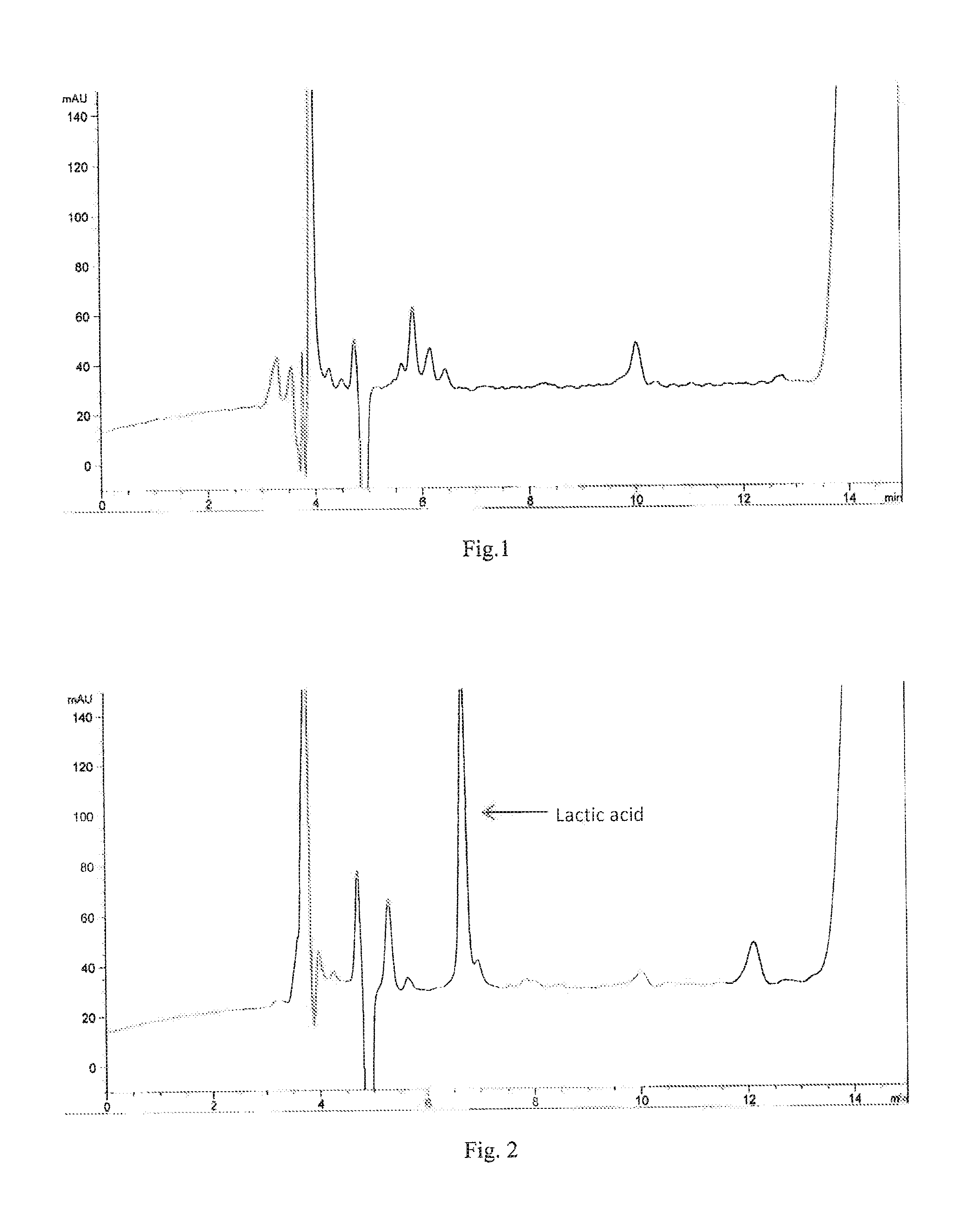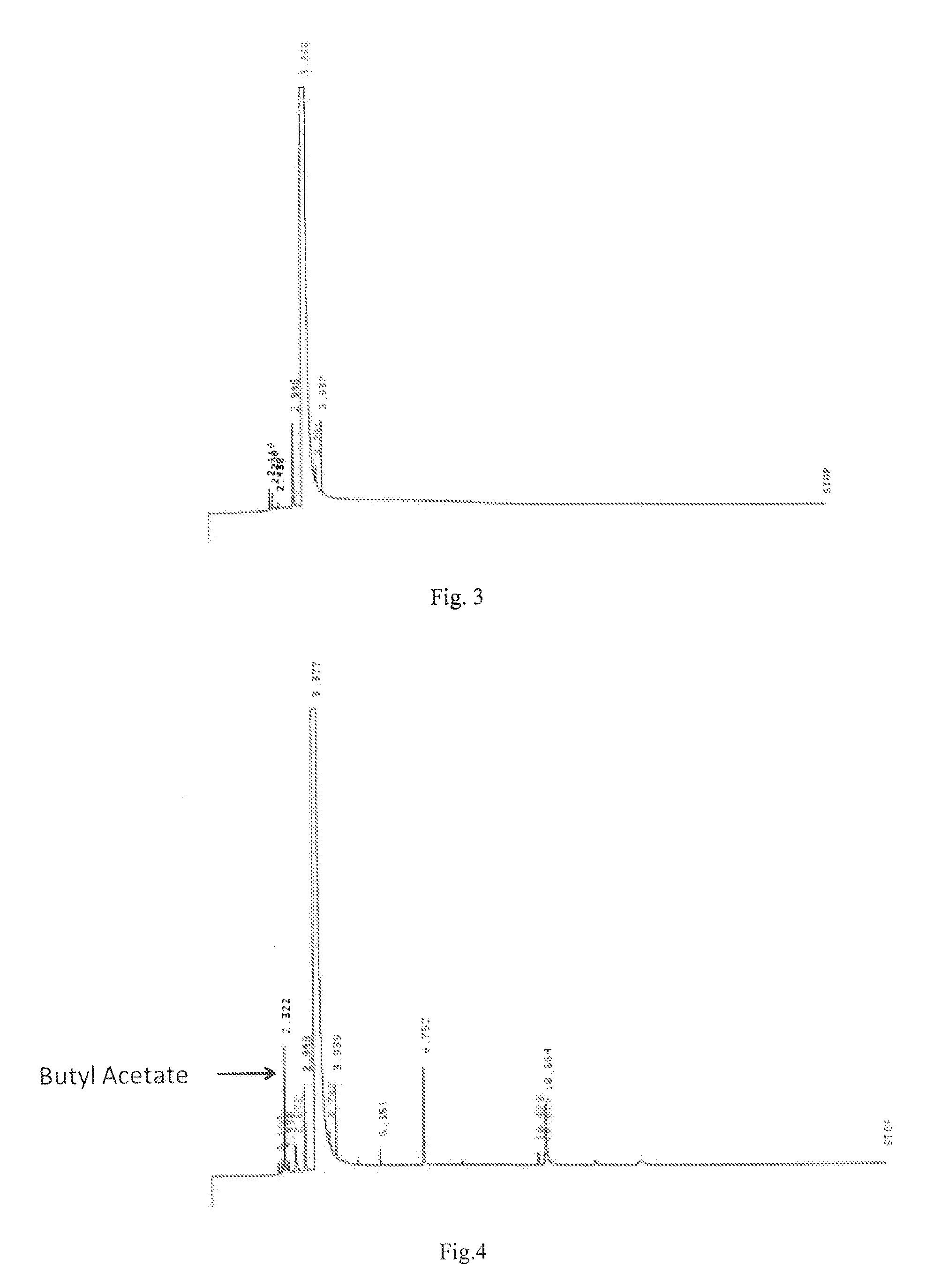Biomass processing method
a technology of lignocellulosic biomass and processing method, which is applied in the preparation of carboxylic compounds, organic chemistry, chemistry apparatus and processes, etc., can solve the problems of crop competition, crop switching and price increases for food products, and the effectiveness of hemicellulosic feedstock fermentation is limited
- Summary
- Abstract
- Description
- Claims
- Application Information
AI Technical Summary
Benefits of technology
Problems solved by technology
Method used
Image
Examples
example 1
Production of Sodium Lactate and Lactic Acid from Hemicellulosic Stream
[0081]a) To a 250 mL flask was charged xylan (3.301 g, from beech wood, Sigma-Aldrich, 96.4% purity based on HPLC area) followed by water (50 mL), concentrated H2SO4 (0.5 mL) and n-butanol (30 mL, purity determined by GC analysis, see FIG. 3). The suspension was stirred and heated to reflux for 3 hours during which all the suspended tarry material dissolved.
[0082]b) The reaction mixture was then cooled to ambient temperature and the layers were separated. The organic n-butanol layer was dark coloured, consistent with the removal of lignin residues, and the lower aqueous layer was pale straw / yellow coloured. Analysis of the n-butanol layer by GC indicated the presence of butyl acetate (FIG. 4). Analysis of the aqueous layer by HPLC showed no visible peak corresponding to acetic acid (FIG. 1).
[0083]c) The separated aqueous layer (50.9 g) was then added over a period of 60 min to 50% aqueous sodium hydroxide solutio...
example 2
Processing of a Pre-Hydrolysate Liquor as Hemicellulosic Stream
[0084](i) Analysis of Hemicellulosic Stream (Pre-Hydrolysate Liquor) for Acids
[0085]Samples of pre-hydrolysate liquor obtained from a commercial dissolving pulp process were analysed for acetic acid and formic acid content (by HPLC) as well as lignin content (by UV spectroscopy) and found to contain the following concentrations: acetic acid, 0.64% w / v; formic acid, 0.07 % w / v; and lignin, 0.65% w / v.
[0086](ii) Determination of Saccharide Content
[0087]To a measured amount of pre-hydrolysate liquor, sulphuric acid (1% v / v based on the volume of PHL) was added and the suspension was heated to reflux for three hours. The reaction mixture was cooled and analysed for monosaccharide content by IC specific for monosaccharides. The results indicated that the hydrolysis generated mainly xylose (2.48% w / v) with some glucose, arabinose, galactose and mannose.
[0088](iii) Concentration of pre-hydrolysate liquor:
[0089]To a 2000 mL evapo...
example 2 (
EXAMPLE 2(D)
Treatment of Concentrated Pre-Hydrolysate Liquor Using Aqueous H2SO4
[0098]To a 250 mL round bottomed flask equipped with reflux condenser was charged the concentrated hydrolysate liquor (50 mL / 54 g) followed by concentrated sulphuric acid (1.6 mL). The suspension was stirred and heated to reflux for three hours and cooled to ambient temperature. To this reaction mixture, n-butanol (30 mL) was added and the biphasic mixture was stirred and heated to reflux for one hour during which all the colour and suspended solids dissolved. The reaction mixture was then cooled to ambient temperature and the layers were separated. The organic phase was dark coloured and the lower aqueous phase was pale straw / yellow coloured. The separated aqueous phase (47 mL) was analysed for monosaccharide and lignin content and the following results were found:
ligninxyloseglucosearabinosegalactosemannoseligninextracted% w / v% w / v% w / v% w / v% w / v% w / v% w / w9.110.490.220.421.010.2790.5
[0099]The separate...
PUM
| Property | Measurement | Unit |
|---|---|---|
| Temperature | aaaaa | aaaaa |
| Temperature | aaaaa | aaaaa |
| Temperature | aaaaa | aaaaa |
Abstract
Description
Claims
Application Information
 Login to View More
Login to View More - R&D
- Intellectual Property
- Life Sciences
- Materials
- Tech Scout
- Unparalleled Data Quality
- Higher Quality Content
- 60% Fewer Hallucinations
Browse by: Latest US Patents, China's latest patents, Technical Efficacy Thesaurus, Application Domain, Technology Topic, Popular Technical Reports.
© 2025 PatSnap. All rights reserved.Legal|Privacy policy|Modern Slavery Act Transparency Statement|Sitemap|About US| Contact US: help@patsnap.com


